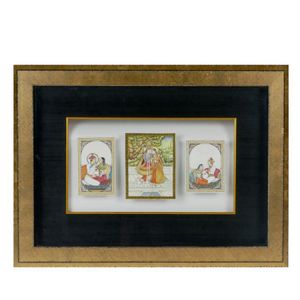The important Australian 'Baggy Green' Test cricket cap of 'W.A.S. 'Bert' Oldfield' from the 1932-1933 'Bodyline' series, green wool, embroidered with the Australian coat-of-arms worked in gold and silver wire and coloured silk, the series date below '1932-33', with a 'Farmers Sydney' label inscribed in ink 'W.A.Oldfield', framed with a black and white photograph of Oldfield, together with a copy of The Larwood Story: A Cricketer's Biography, (the dust jacket framed separately), opened at the page describing the infamous encounter between Oldfield and the English fast bowler, Harold Larwood, on 17 January 1933, when Oldfield was struck in the head off Larwood's delivery, suffering a fractured skull. An area of separation to one of the seams in the cap where Oldfield was struck, is a further reminder of the incident. 88 x 97.5 cm (overall). Accompanied by a letter from Russell Crowe stating his ownership. Provenance: Sport in Australia, Christie's Australia, Melbourne, 4 October 2000, lot 481. Mr Russell Crowe, Sydney, acquired from the above. Show Catalogue Notes. Catalogue Notes. Since its inception around the turn of the twentieth century, the distinctive, loosely formed dark green wool 'Baggy Green' cap of the Australian Test cricket team has been regarded as an icon not only of the pinnacle of achievement in sport at a national level, but also as an enduring symbol of the qualities of fair play and sportsmanship. The 'Baggy Green' cap presented here, is a primary artefact from the infamous 'Bodyline Series' of Test cricket, when the traditional notions of gentlemanly good manners in the sport were threatened by an aggressive playing tactic adopted by the English team to combat the seemingly unstoppable batsman, Donald Bradman, causing a furore domestically and internationally and leading to tension between the governing cricket bodies of the two nations. The 'Bodyline' tactic entailed bowling the cricket ball in line with the body of the batsman, in the hope of provoking an uncontrolled response as the batsman swung with less certainty in order to protect themselves. In the days preceding the helmet used in modern day cricket, the 'Baggy Green' cap was the only thing offering limited protection to the head of the batsman, so the 'Bodyline' approach was viewed as a very controversial method of bowling. William Albert Stanley 'Bert' Oldfield (1894-1976) commenced his first class cricket career in 1919, following service as a Corporal in the 15th Field Ambulance for the Australian Imperial Force in World War I. Oldfield played his first Test against England in Sydney in 1921-1922 and was selected as wicket-keeper for the 1924-1925 Ashes series. However it was as a batsman that Oldfield faced English fast bowler, Harold Larwood (1904-1995), on the afternoon of 17 January 1933, when he was to be written into the 'Bodyline' story. The English captain, Douglas Jardine, (1900-1958) had been under fire throughout the series for instructing his bowlers to use the 'Bodyline' tactic, which was viewed as overly aggressive and posing a physical danger to batsmen. Oldfield suffered a fractured skull when he was struck on the right side of the temple by a cricket ball bowled by Larwood, and was carried off the ground unconscious. He recovered for the fifth test in the series. Guy Cairnduff
You must be a subscriber, and be logged in to view price and dealer details.
Subscribe Now to view actual auction price for this item
When you subscribe, you have the option of setting the currency in which to display prices to $Au, $US, $NZ or Stg.
This item has been sold, and the description, image and price are for reference purposes only.
This item has been included into following indexes:
-
bodyline series - cricket memorabilia, matches, teams and tours
65
-
Bradman, Don (Australia) - menus, programs, letters, scorecards
162
-
caps, baggy green - cricket memorabilia, clothing and equipment
57
-
helmets - cricket memorabilia, clothing and equipment
16
-
Larwood, Harold (England) - cricket memorabilia, named players
41
-
The 1932-33 Bodyline Tour - cricket memorabilia, matches, teams and tours
73




